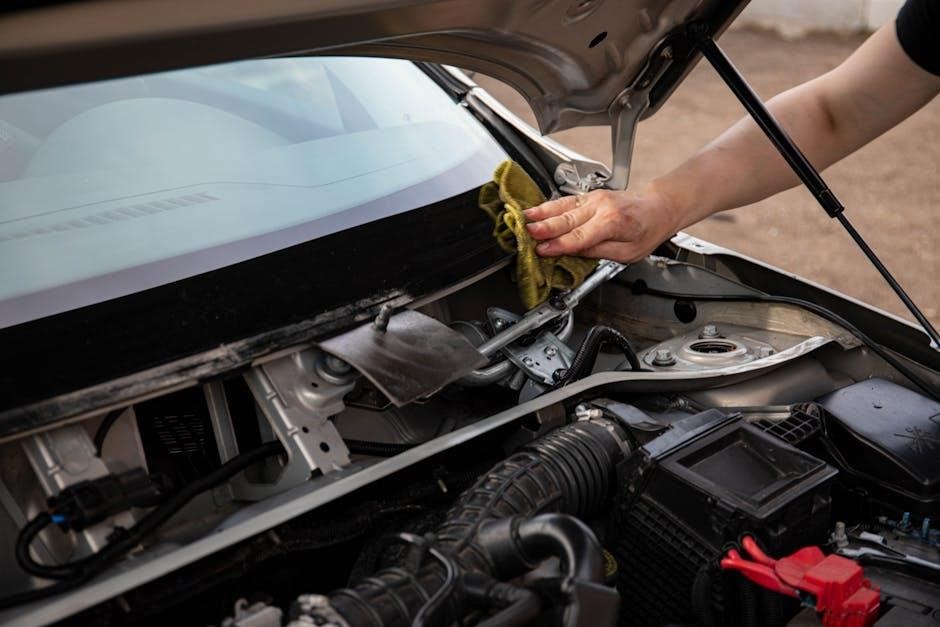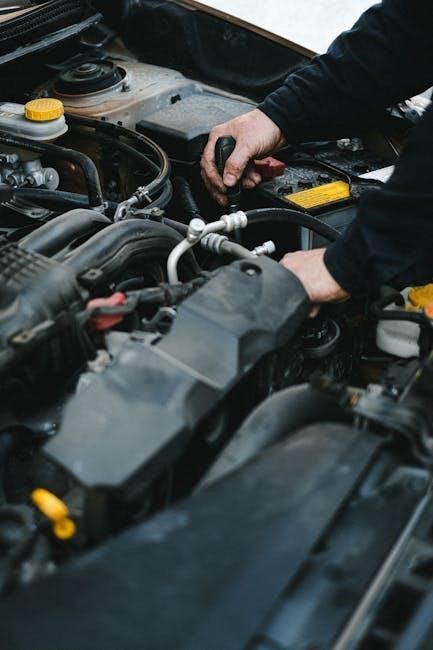The Peabody Developmental Motor Scales-2 (PDMS-2) is a comprehensive assessment tool for evaluating motor skills in children from birth to age 5. This manual provides standardized scoring procedures, ensuring accurate and reliable results. It includes detailed guidelines for administering six subtests: Reflexes, Stationary, Locomotion, Object Manipulation, Grasping, and Visual-Motor Integration. The scoring system (2, 1, 0) helps identify mastery, partial mastery, or inability to perform tasks. This resource is essential for professionals to assess motor development, identify delays, and monitor progress effectively.
1.1 Overview of PDMS-2
The Peabody Developmental Motor Scales-2 (PDMS-2) is a standardized assessment tool designed to evaluate motor skills in children from birth to 5 years. Published by PRO-ED, it was developed by M. Rhonda Folio and Rebecca R. Fewell. The PDMS-2 consists of six subtests: Reflexes, Stationary, Locomotion, Object Manipulation, Grasping, and Visual-Motor Integration. It provides a comprehensive measure of gross and fine motor abilities, aiding in early identification of motor delays and planning interventions.
1.2 Purpose of the Scoring Manual
The PDMS-2 Scoring Manual provides standardized criteria for evaluating children’s motor skills, ensuring accurate and reliable scoring. It guides examiners in interpreting test results, identifying developmental delays, and monitoring progress. The manual includes detailed instructions for scoring each subtest, enabling professionals to consistently assess motor abilities and inform intervention strategies. It is an essential resource for therapists, educators, and researchers working with young children.

Components of PDMS-2
The PDMS-2 consists of six subtests assessing motor skills: Reflexes, Stationary, Locomotion, Object Manipulation, Grasping, and Visual-Motor Integration. These components evaluate gross and fine motor abilities in children.
2.1 Subtests of PDMS-2
The PDMS-2 includes six subtests: Reflexes, Stationary, Locomotion, Object Manipulation, Grasping, and Visual-Motor Integration. These assess various motor skills, from basic reflexes to complex fine motor tasks. Each subtest evaluates specific abilities, providing a comprehensive understanding of a child’s motor development. The structure ensures a thorough assessment of both gross and fine motor functions, aiding in identifying strengths and areas needing support.
2.2 Structure of the Examiner’s Manual
The Examiner’s Manual is structured to guide professionals through the administration and scoring of the PDMS-2. It includes detailed instructions for each subtest, scoring criteria, and interpretation guidelines. The manual also provides examples of item administration, scoring conventions, and methods for recording results. Additional resources, such as the Examiner Record Booklet and Profile/Summary Form, are referenced to support accurate and efficient assessment practices.

Administration Guidelines
Administration involves preparing materials, ensuring a suitable environment, and following standardized procedures. The assessment begins with easier tasks, progressing to more complex ones, ensuring accurate results.
3.1 Preparation for Administration
Preparation involves gathering necessary materials, such as the Examiner’s Manual, test items, and record forms. Ensure a quiet, safe environment with minimal distractions. Review the manual to understand test procedures and scoring criteria. Familiarize yourself with the subtests and practice administering them if needed. Prepare the Examiner Record Booklet and Profile/Summary Form for recording scores. Ensure all materials are organized and ready for the assessment session.
3.2 Conducting the Assessment
Begin by introducing the assessment to the child and ensuring they are comfortable. Demonstrate tasks clearly and provide practice items if necessary. Administer subtests in the recommended order, starting with simpler tasks. Score each item as 2 (mastered), 1 (partially mastered), or 0 (unable to perform). Record scores immediately in the Examiner Record Booklet to ensure accuracy. Provide clear instructions and minimize distractions during the session.

Scoring Criteria
Items are scored as 2 (mastered), 1 (partially mastered), or 0 (unable to perform). Detailed criteria in the Examiner’s Manual ensure consistency in scoring. Each score reflects the child’s ability to complete tasks accurately and independently, providing a clear framework for evaluating motor skills effectively.
4.1 Item Scoring (2, 1, 0)
Each item is scored on a 3-point scale: 2 (mastered), 1 (partially mastered), or 0 (unable to perform). Scoring is based on the child’s ability to complete tasks independently and accurately. The Examiner’s Manual provides detailed criteria for each score, ensuring consistency. This system allows for precise assessment of motor skills, helping to identify strengths, weaknesses, and developmental needs effectively.
4.2 Recording Scores
Recording scores is a critical step in the PDMS-2 assessment process. The Examiner Record Booklet (Blue) is used to document raw scores for each subtest. These scores are then transferred to the Profile/Summary Form (Red), which provides a visual representation of the child’s performance. The manual emphasizes the importance of accurate and organized recording to ensure reliable interpretation of results and effective progress monitoring.

Interpretation of Scores

The PDMS-2 provides standard scores and a Total Motor Quotient (TMQ) to evaluate a child’s motor abilities. These scores help identify strengths, weaknesses, and track progress over time.
5.1 Understanding Standard Scores
Standard scores for PDMS-2 subtests and composites are based on a mean of 10 and a standard deviation of 3. These scores allow comparison of a child’s performance to peers. The Total Motor Quotient (TMQ) provides an overall estimate of motor skills. Understanding these scores helps identify developmental strengths, weaknesses, and track progress over time, enabling targeted interventions and monitoring effectiveness.
5.2 Total Motor Quotient (TMQ)
The Total Motor Quotient (TMQ) is a composite score derived from the PDMS-2 subtests, providing an overall estimate of a child’s motor abilities. It is calculated by combining standard scores from all subtests, with a mean of 100 and a standard deviation of 15. The TMQ allows for comparison to peers and identification of motor strengths or weaknesses. It is a critical measure for assessing overall motor development and planning interventions.

Applications of PDMS-2
The PDMS-2 is widely used to assess motor skills in children, identify developmental strengths and weaknesses, and monitor progress over time. It aids in planning targeted interventions and evaluating the effectiveness of motor development programs, ensuring comprehensive support for children’s growth.
6.1 Identifying Motor Development Strengths and Weaknesses
The PDMS-2 helps professionals identify motor development strengths and weaknesses in children through standardized assessment. It evaluates gross and fine motor skills, providing detailed insights into areas like reflexes, locomotion, and object manipulation. By scoring each subtest, examiners can pinpoint specific abilities, enabling tailored interventions and fostering individualized support for children’s motor development needs.
6.2 Monitoring Progress and Intervention Effectiveness
The PDMS-2 is invaluable for tracking a child’s motor development progress over time. By administering the assessment at intervals, professionals can measure changes in skills and evaluate the impact of interventions. Standardized scores allow for precise comparisons, helping to determine whether interventions are effective. This tool supports data-driven decision-making, ensuring targeted support and optimizing outcomes for children with motor challenges.

Resources for Examiners
The PDMS-2 provides essential tools like the Examiner’s Manual, Examiner Record Booklet (blue), and Profile/Summary Form (red) to ensure accurate scoring and organized data management.
7.1 Examiner Record Booklet
The Examiner Record Booklet (blue) is a crucial tool for documenting test results. It provides structured space for recording scores from each subtest, ensuring systematic and accurate data entry. This booklet helps examiners keep track of individual progress and compare results over time, facilitating consistent and reliable assessment. Proper use enhances organization and supports effective score interpretation.
7.2 Profile/Summary Form
The Profile/Summary Form (red) provides a comprehensive overview of a child’s performance across all PDMS-2 subtests. It summarizes standard scores, highlighting strengths and weaknesses. This form aids in tracking progress over time and planning targeted interventions. By visualizing motor skill development, it supports effective communication with parents and professionals, ensuring informed decision-making for individualized support and monitoring intervention effectiveness.

Training and Support
Examiner training is crucial for accurate PDMS-2 administration and scoring. Support materials, including manuals and forms, ensure proper test implementation and interpretation, enhancing assessment reliability and effectiveness.
8.1 Importance of Examiner Training
Proper training is essential for examiners to accurately administer and score the PDMS-2. It ensures consistency, reliability, and validity in assessing motor skills. Training covers test setup, item administration, scoring criteria, and interpretation of results. It also helps examiners identify motor delays and strengths, enabling effective intervention planning. Ongoing training supports professional development and ensures high-quality assessments, which are critical for monitoring child development and measuring progress over time.
8.2 Available Support Materials
The PDMS-2 offers various support materials to aid examiners, including the Examiner’s Manual, Profile/Summary Form, and training programs. These resources provide detailed instructions, scoring guidelines, and interpretation tips. Additional materials, such as workshops and online courses, enhance examiners’ skills. Technical support from publishers like PRO-ED is also available to address questions. These tools ensure accurate administration, scoring, and interpretation, supporting effective assessment and intervention planning for children’s motor development.
The PDMS-2 Scoring Manual is an essential tool for accurately assessing motor skills in children. It provides clear guidelines, enabling professionals to identify developmental strengths and weaknesses effectively, while monitoring progress and supporting intervention planning.
9.1 Summary of Key Points
The PDMS-2 Scoring Manual provides a structured approach to assessing motor development in children from birth to age 5. It includes six subtests: Reflexes, Stationary, Locomotion, Object Manipulation, Grasping, and Visual-Motor Integration. The scoring system (2, 1, 0) ensures consistent evaluation of motor skills. This tool is invaluable for identifying developmental strengths, weaknesses, and tracking progress over time, making it a critical resource for professionals in early childhood development.
9.2 Final Thoughts on Effective Use of PDMS-2
The PDMS-2 is a valuable tool for assessing motor development in children, offering insights into gross and fine motor skills. Proper training and adherence to the scoring manual ensure accurate results; Regular use aids in identifying developmental delays and tracking progress. By leveraging its structured approach, professionals can make informed decisions to support children’s motor development effectively. Consistent use enhances intervention planning and monitoring outcomes.









































































